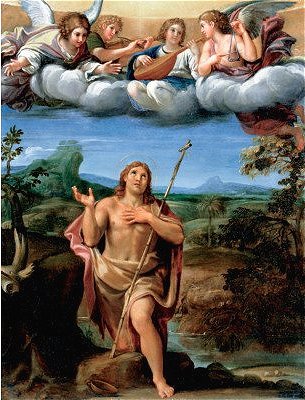 |
|
SAINT JOHN THE BAPTIST IN THE WILDERNESS
Francesco Albani, Italian 1578-1660
SN 115 Oil on Copper 1600/06
by Robert Anderson
ARTIST
Francesco Albani was born in Bologna, and while still a teenager joined
the Carracci Academy where life drawing and theoretical discussions formed the core of his
education. Taught by Annibale Carracci, he absorbed the ideas of early Baroque classicism
and integrated that style into his art. He worked with Annibale (to whom this painting was
originally attributed) as chief assistant on several palace commissions, most notably the
Palazzo Farnese. His paintings included numerous cabinet pictures on religious and
mythological subjects, in addition to both large-scale altarpieces and easel paintings.
His clients consisted of a growing number of wealthy patrons. King
Louis XIV of France had a large collection of cabinet pictures by Albani at the end of the
17th century. In 1618 he opened a studio in Bologna which functioned as both a school for
artists and a workshop for his own master designs. He is noted for his paintings of
children and it has been rumored that he often used his own twelve (12) children as models
for cherubs and cupids - supposedly hanging them from the ceiling with ropes. |
SUBJECT
John the Baptist was a second cousin to Jesus. His mother Mary and
John's mother Elizabeth being cousins. He appeared in manhood as a herald preaching the
coming of the "Kingdom of God", repentence and the need for baptism for the
forgiveness of sins. He was a ascetic or hermit who had lived and preached in the
wilderness, living on locusts and honey and dressed in the skins of animals. It was John
who testified to the coming of Jesus as the Messiah, and who baptised him in the River
Jordan.
When John criticized the "incestuous union of Herod and Herodias
he was thrown into jail and subsequently beheaded at Herodias' instigation and Salome's
request.
PAINTING
Albani drew his inspiration for this painting from his mentor, Annibale
Carracci, whose own "St. John in the Wilderness" shows the prophet in a similar
pose. We see a young, muscular John kneeling with classical grace, calm and frontality of
a Greek statue. One foot seems to jut out of the picture plane in Baroque style. His eyes
are turned upwards toward four music making angels resting on a billowing cloud 3/4 of the
way up. The cloud horizontally divides the work into two separate sections. The assemblage
of angels and the figure of John fill the foreground reducing the importance of the
landscape in the background.
Have the angels come to him to reveal his mission to preach baptism for
the remission of sin ? John has climbed to the top of a mountain - his staff with a cross
at its top points heavenward - a bowl sits at his feet. Below a river wends its way from
the foreground to the middle ground and may allude to the River Jordan - the future site
of John's many baptisms. John's halo is clearly deliniated which is not in keeping with
the ideals of naturalism proposed by Carracci. Over all the painting exudes a feeling of
calm piety. The paintings small size and subject suggests that it was a cabinet painting
to be displayed in a wealthy patron's home.
HISTORICAL CONTEXT
This is a painting that is in accordance with the directives to artists
which came out of the Council of Trent. In the period of the Counter Reformation artists
were directed to paint mystical Biblical occurances in a realistic but emotional manner.
They were to emphasize the mystery in the lives of Christian personalities ; the miracles
and martyrdoms in emotional terms in order to impress and "educate" people,
thereby bringing them back to the Church and reinforcing its doctrines. |
